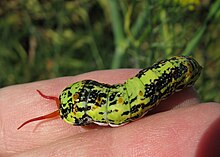Osmeterium

Upper: Osmeterium partly everted. Lower: undisturbed
Theosmeteriumis a defensive organ found in allpapilionidlarvae, in all stages.[1]The organ is situated in theprothoracicsegment and can be everted when the larva feels threatened. The everted organ resembles a fleshy forked tongue (not unlike a snake tongue), and this along with the large eye-like spots on the body might be used to startle birds and small reptiles. The osmeterial organ remains inside the body in the thoracic region in an inverted position and is everted when the larva is disturbed in any way emitting a foul, disagreeable odor which serves to repelants,[2]smallspiders[3]andmantids.[4]To humans, this odour is rather strong but not unpleasant, usually smelling like a concentrated scent of the caterpillar's food plant and pineapple.
The constitution of theosmeterial secretionvaries from species to species and containsmonoterpene hydrocarbons,sesquiterpenic compoundsor a mixture ofaliphatic acidsandesters.
The fine structure of the osmeterium ofPapilio demoleuslibaniusFruhstorfer has been studied and found to contain 3 types of specialised cells for synthesis, acid secretion,[5]and storage[6]of the osmeterial secretion.
Structure
[edit]
The fine structure of the osmeterium gland ofPapiliolarvae consists of the following cell types.
- Ellipsoid gland cells have an extensively infolded basalplasma membrane,abundantribosomesand whorls ofsmooth endoplasmic reticulum.Theapicalplasma membrane bears longmicrovilliextending into a mass of granular material containing electron-lucid cavities. Tangential slits occur in theepicuticle.These cells are presumed to be organic acid-secreting cells.
- Tubular arm cells contain heterogeneous, electron-dense inclusions, extensively-branched nuclei and largemitochondria,sometimes distended with electron-dense material. The apical plasma membrane bears short microvilli. The inner, dense epicuticle forms a complex ramifying system. These glandular cells presumably synthesize and secrete the mature secretion.[5]
Specific study ofPapilio demoleus libaniusFruhstorfer shows the possible existence of a third type of cell
- Slack cells, loosely surround the ellipsoid gland cells. These cells possess papillae, well-developed, rough endoplasmic reticulum, and numerous secretory vacuoles of various sizes and electron density. They may function as storage cells.[6]
Osmeterial secretion
[edit]The osmetrial secretion consists of a mixture of volatileorganic acids,such asisobutyric acidand2-methylbutyric acid.[4]
The secretion ofPapilio demodocuspre-finallarvalinstarcontains methyl 3-hydroxybutanoate,3-hydroxybutanoic acid,α-pinene,myrcene,limonene,β-phellandrene,(Z)-ocimene,(E)-ocimene,β-caryophyllene,(E)-β-farnesene,andgermacrene A,as well as a number of unidentifiedsesquiterpenoids.[7]and that of its final instar contains2-methylpropanoic acid,2-methylbutanoic acid, and their methyl and ethyl esters as major constituents.[8]
Volatile components of the secretion ofParnassius glacialis(Parnassiinae,Parnassiini) consisted ofisobutyric acid,2-methylbutyric acid,and their methyl esters. That ofSericinus montela(Parnassiinae,Zerynthiini) was characterized asmonoterpenehydrocarbonscomprising β-myrcene (major), α-pinene,sabinene,limonene, and β-phellandrene, and ofPachliopta aristolochiae(Papilioninae,Troidini) was composed of numerous sesquiterpene hydrocarbons, includingα-himachalene,α-amorphene, and germacrene A, and a few oxygenated sesquiterpenoids.[9]
Studies on osmeterial secretion makes it possible to classify the Papilionid species into two large categories on the basis of the chemical property of osmeterial secretion.[10]
- One is a group in which the chemical constitution of osmeterial secretion of the last larval instar markedly differs in quality from those of the younger larvae. The results derived fromPapilio protenor,[10]P. demodocus[8]and otherPapiliospecies (P. helenus,P. machaon,P. memnon,P. bianor,P. maccki,P. xuthus,etc., unpublished work) may assign the genusPapilio(tribe Papilionini) to this group, which can be termed 'heterogeneous type'.
- The generaLuehdorfia(tribeZerynthiini),Graphium(tribeGraphiini) andAtrophaneura(tribeTroidini) apparently belong to the other group, in which no qualitative change of osmeterial secretion occurs at the last larval ecdysis. This group can be designated as 'homogeneous type', which is further subdivisible into three types.
- Monoterpene -Luehdorfia(Zerynthiini, Parnassiinae)
- Sesquiterpene -Atrophaneura(Troidini, Papilionnae)
- Aliphatic acid and ester -Graphium(Graphiini, Papilioninae)
Function
[edit]Eversion of the osmeterial gland is demonstrably effective in reducing predation by ants and small spiders,[3]and its chemical constituents have been shown to repel or kill ants,[2][11]and mantids.[1][4]
References
[edit]- ^abChattopadhyay, J. 2011. The structure and defensive efficacy of glandular secretion of the larval osmeterium in Graphium agamemnon agamemnon Linnaeus, 1758 (Lepidoptera: Papilionidae).
- ^abEisner, T., and Meinwald, Y.C. 1965. The defensive secretions of a caterpillar (Papilio). Science, N.Y. 150: 1733-1735.
- ^abDamman, H. 1986. The osmeterial glands of the swallowtail butterfly Eurytides Marcellus as a defense against natural enemies. Ecol.Entomol. 11: 261-265.
- ^abcChow, Y.S. and Tsai, R.S. 1989. Protective chemicals in caterpillar survival. Experientia (Basel) 45 (4): 390-392.
- ^abCrossley, A.C. and Waterhouse, D.F. 1969. The ultrastructure of the osmeterium and the nature of its secretion in Papilio larvae (lepidoptera). Tissue & Cell 1: 525-554.
- ^abLu, Chow-Chin; Yien Shing Chow (1991) Fine structure of the larval osmeterium ofPapilio demoleus libanius(Lepidoptera: papilionidae). Ann. Entomol. Soc. Am. 84(3):294-302.
- ^Burger, B.V., Munro, Z., Roth, M., Spies, H.S.C., Truter, V. and Greetsema, H. 1985. Constituents of osmeterial secretion of prefinal instar larvae of citrus swallowtail, Papilio demodocus (Esper) (Lepidoptera: Papilionidae). J. Chem. Ecol. 11 (8): 1093-1114.
- ^abBurger, B.V., Roth, M., Le Roux, M., Spies, H.S.C., Truter, V. and Geertsema, H. 1978. The chemical nature of the defensive larval secretion of the citrus Swallowtail, Papilio demodocus. J. Insect Physiol. 24: 803-805.
- ^Keiichi Honda, Nanao Hayashi. Chemical nature of larval osmeterial secretions of papilionid butterflies in the genera Parnassius, Sericinus and Pachliopta. Journal of Chemical Ecology June 1995, Volume 21, Issue 6, pp 859-867.
- ^abHONDA K. 1980: Osmeterial secretions of papilionid larvae in the genera Luehdorfia, Graphium and Atrophaneura (Lepidoptera). Insect Biochem. 10: 583-588.
- ^HONDA, KEIICHI. Defensive potential of components of the larval osmeterial secretion of papilionid butterflies against ants. Physiological Entomology - Blackwell Publishing Ltd.[1]DO - 10.1111/j.1365-3032.1983.tb00346.x
